|

Alexander III the Great 356-323 BC
Conquering the World in a Decade
According to
 Napoleon, Alexander was one of the
seven greatest generals in history.
Napoleon, Alexander was one of the
seven greatest generals in history.
Let's take it from a pro.
|
|
Above Image
Alexander the Great, Marble, British
Museum.
Photo Yair Haklai |
Alexander of Macedonia, or
Alexander III, was born in Pella, Macedonia.
His life is at the root of many
legends.
Alexander the
Great in a Nutshell
Alexander conquered the entire
then known world in a decade, which included the
defeat of the ruling
 Persian Empire.
Persian Empire.
And here is the map
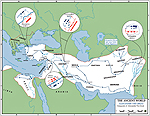
The Conquests of Alexander the Great 336-323 BC
Alexander's
Family, Friends, and Peers
His
father,
 Philip II, was assassinated when Alexander was
20 years old. Philip was the 18th king of Macedonia. Alexander
became his successor in 336 B.C. Philip II, was assassinated when Alexander was
20 years old. Philip was the 18th king of Macedonia. Alexander
became his successor in 336 B.C.
Interesting tidbit: 336 B.C. was also the year in which
 Darius
III became king of the Persian Empire. Darius
III became king of the Persian Empire.
Alexander's mother was
Olympias.
Olympias was the princess of Epirus. Here is a
 map of Epirus. And if you watched map of Epirus. And if you watched
 the
movie Alexander closely, you know that she was the kind of gal who
knew what she wanted. the
movie Alexander closely, you know that she was the kind of gal who
knew what she wanted.
Then
there was Aristotle. Aristotle was Alexander's tutor during his
childhood.
Alexander's main male lover was Hephaestion, one of
his bodyguards. When Hephaestion died, Alexander arranged a
humongous funeral.
Roxana
, a Bactrian princess, became Alexander's wife in 327 B.C. They had a son together, Alexander IV.
Roxana was Alexander's wife until his death.
Three years later, in 324 BC, Alexander also married Stateira II and Parysatis II in a double wedding at Susa
(modern-day Shush, Iran). These marriages were largely political, aimed at consolidating his rule over the Persian Empire.
Stateira II (also called Barsine) was the daughter of Darius III, and might or might not have been murdered by Roxana to prevent rival
offspring with claims to the throne.
Parysatis II was the daughter of Artaxerxes III.
Alexander's firstborn son was
Heracles
by
Barsine
(this is a different Barsine than Stateira). Unfortunately for Heracles, he was illegitimate. But he
was strangled by Polysperchon around the year 310 BC, anyway. Heracles was about 18 years old.
Macedonian General Antipater was in charge
of everything in Macedonia while Alex was gone fighting.
Antipater died in 319 B.C.
Controversy: Did
Alexander Order the Assassination of his Father?
The majority of historians doesn't think so.
Alexander the
Great's Army
Alexander's army was rather small. He had at his disposal 5,000
cavalrymen and 30,000 infantrymen.
Not being fear inspiring in
size, the army's strength lay in its discipline and
organization. Mastering the
 phalanx with its arrangements of
long pikes, Alexander's army swept through Persian forces. phalanx with its arrangements of
long pikes, Alexander's army swept through Persian forces.
ALEXANDER'S BATTLES
The four major battles that Alexander fought were the
following:
Battle of the Granicus 334 BC
Battle of Issus 333 BC
Battle of Gaugamela 331 BC
Battle of the Hydaspes 326 BC
Again the previously posted map on which you can see the locations
of these four important battles.

The Conquests of Alexander the Great 336-323 BC
More details on these and Alexander's
other battles below, starting with the year 338 BC.
The Battles of
Alexander the Great
In 338 BC, and alongside his father Philip, Alexander fought in
the
 Battle of Chaeronea. Battle of Chaeronea.
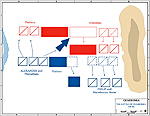
Map of the Battle of Chaeronea 338 BC
Thanks to his father, Macedonia had
become a dominant power in Greece by the time he succeeded to the
throne in 336 BC.
After becoming king of Macedonia, Alexander gained
several victories over the northern barbarians who had
attacked Macedonia, and destroyed Thebes, which, in
conjunction with Athens, had taken up arms against the
Macedonians upon receiving the news of Philip's death.
Alexander moved swiftly and thoroughly.
He then prepared for his invasion of Asia, an operation his father
had already envisioned back in the days.
334 BC - Alexander passed the
Hellespont.
Early summer of the year 334 B.C. -
The battle on the banks of the river
 Granicus brought
Alexander his first victory over Darius III and the Persians. Darius was not overly concerned,
but he should have been. Granicus brought
Alexander his first victory over Darius III and the Persians. Darius was not overly concerned,
but he should have been.
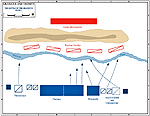
Map of the Battle of the Granicus 334 BC
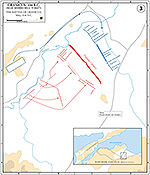
334 BC Battle of the Granicus (Order of
Battle)
In 333 BC, the battle at
 Issus looked like a
cakewalk for Darius, because he had an army of some 600,000
men at his disposal. Issus looked like a
cakewalk for Darius, because he had an army of some 600,000
men at his disposal.
Not so. The battle of Issus turned out to be a disaster for
the Persians. Darius had to flee for his life. His army was
defeated; his mother, wife, sister, and children had been captured by
Alexander.
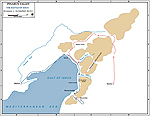
Map of the Battle of Issus 333 BC - Movements to the Battlefield
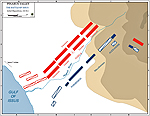
Map of the Battle of Issus 333 BC - Initial Situation
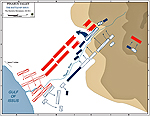
Map of the Battle of Issus 333 BC - Decisive Action
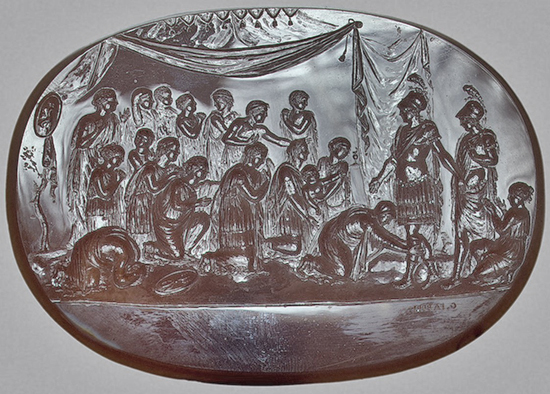
The Mercy of Alexander: Alexander the Great,
Accompanied by Haephestion, before the Family of
Darius, King of Persia
Sard Carving by
Giulio Fabri, Late 18th Century. State Hermitage
Museum St. Petersburg
Interestingly, Alexander didn't pursue Darius after the battle
at Issus. Instead, he decided to spend January through July
332 B.C. in front of the closed gates of the city
Tyre.
Similar to Darius III before
the Battle of the Granicus, the
citizens of Tyre were not too alarmed when Alexander set up
his siege of their city. Tyre was located on a cozy
little island half a mile away from the mainland, framed by
sturdy walls a hundred and fifty feet high. Plus, Alexander
didn't have a navy.
How did Alexander solved the
problem?
He decided to build a causeway across the channel and,
in addition, he borrowed a
 Phoenician navy. That did the trick
and Alexander's troops were able to breach Tyre's
walls. The citizens of Tyre paid dearly for their resistance — some 8,000
were slaughtered right away, 2,000
were impaled, and 30,000
were sold into slavery. Phoenician navy. That did the trick
and Alexander's troops were able to breach Tyre's
walls. The citizens of Tyre paid dearly for their resistance — some 8,000
were slaughtered right away, 2,000
were impaled, and 30,000
were sold into slavery.
On this occasion, Alexander
put to work the highest siege towers ever used in the
history of war so far. ( source) source)

 Highest siege towers ever used in war so far.
Highest siege towers ever used in war so far.
And here are the maps of the Siege of Tyre.
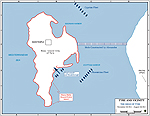
Map of the Siege of Tyre 333-332 BC
After
a short rest in Jerusalem, Alexander went on to Egypt
where he founded the city of Alexandria. The year? 332 B.C.
Persian rule in Egypt was officially
terminated.
See more under
 Governments of Egypt.
Governments of Egypt.
Alexander moved on to Babylon with an army of some 47,000
men. With Darius III still at large, Alexander was itching for
battle.
THE
BATTLE OF GAUGAMELA
On
October 1, 331 B.C., it
followed the
 Battle of Gaugamela which turned out to be the end of
the Battle of Gaugamela which turned out to be the end of
the
 Persian empire. Darius III fled to Bactria where he was
killed. Persian empire. Darius III fled to Bactria where he was
killed.
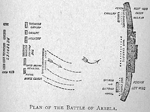
Battle of Gaugamela (Battle of Arbela) 331 BC
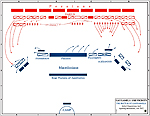
Map of the Battle of Gaugamela 331 BC -
Initial Situation
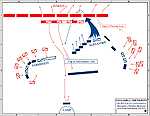
Map of the Battle of Gaugamela 331 BC -
Decisive Action
Babylon's
Surrender
Alexander scored once again in 331 B.C. when
Babylon, Persian's winter capital, was smart enough to surrender. Alexander
loved the city of Babylon and decided it would become
his new capital.
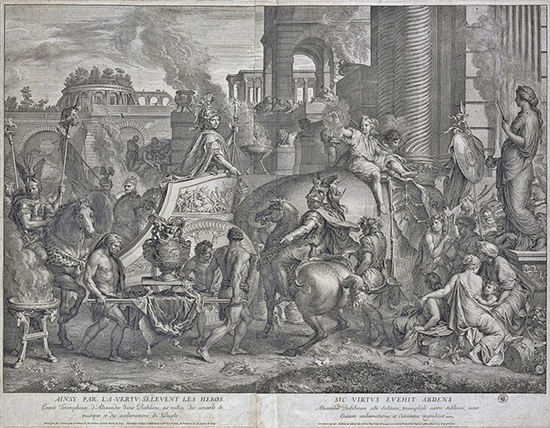
Triumphal
Entrance of Alexander the Great to Babylon
Etching by Gerard
Audran, France, 1675. State Hermitage Museum St. Petersburg
THE BATTLE OF HYDASPES
The
 Battle of the Hydaspes in 326 B.C. was the last of the
four major battles in Alexander's conquest. Battle of the Hydaspes in 326 B.C. was the last of the
four major battles in Alexander's conquest.
It was also the
last battle for one the most famous horses in
history, Alexander's mount
 Bucephalus.
Bucephalus.
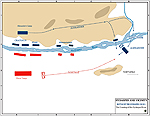
Map of the Battle of the Hydaspes 326 BC - Crossing of the River
This battle proved to be a bit
tricky for Alexander because he had to fight Indian leader
Porus,
who not only was a very strong opponent but who also had 200
serviced war
elephants ready for battle.
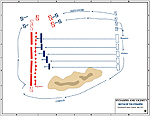
Map of the Battle of the Hydaspes 326 BC - Combined Arms Attack
But the great general managed and the Battle of Hydaspes became yet
another victory for
Alexander.
A new challenge arose for Alexander when his troops refused to march towards the Ganges.
He
commenced the descent of the Indus. On his march he attacked and
subdued several Indian tribes, among others the
Malli, in the
storming of whose capital Mooltan, Alexander was severely wounded.
Alexander directed his admiral, Nearchus, to
sail from the Indus to the Persian Gulf and lead the army
back across Scinde and Beloochistan.
In the summer of 324 BC, a rebellion
broke out at Opis, Mesopotamia. (The exact location of the ancient
city of Opis is unknown.) Alexander addressed this revolt in
his
 Depart! speech, conserved for us by the Greek historian
Arrian. Depart! speech, conserved for us by the Greek historian
Arrian.
Later in 324 BC Alexander returned to Babylon.
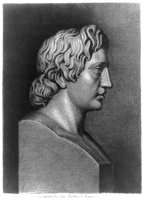
ALEXANDER THE GREAT
Click image to enlarge
Alexander's
Death
Babylon, the year
323 B.C. - Alexander suffered from fever
(some say malaria, soma say typhoid fever, some say he might
have been poisoned) and died. He left a gigantic empire, which reached from Europe
to Asia Minor, Asia, the Middle East, and Egypt.
His dead body was transported into Egypt and buried in Alexandria.
On his death being known at
Greece, the Athenians, and others of the southern states,
took up arms to shake off the domination of Macedon. They
were at first successful, but the return of some of
Alexander's veterans from Asia enabled Antipater to prevail
over them.
Alexander's
Successors
Alexander's
brother Philip ruled Macedonia but only until 317 B.C. because
his mother then murdered him.
After Philip, Alexander Jr. succeeded to
the throne and made it until 311 B.C. He was then murdered
by Cassander, one of his father's generals.
Son
Heracles was murdered as well. That was
in 309 B.C.
Thus,
Alexander the Great's family tradition of ruling came to an
end. Alexander's generals continued to rule instead.
The Diadochi
306 BC — After a long series of
wars with each other, and after all
the heirs of Alexander had been murdered, his principal
surviving
generals assume the title of king, each over the provinces
which
he has occupied. They were also called the
 Diadochi. Diadochi.
The four chief among them were
Antigonus
Ptolemy
Lysimachus
and Seleucus.
Antipater was
now dead, but his son Cassander succeeded to his power in
Macedonia and Greece.
How did the generals manage?
General
 Antigonus set
himself up to rule over Asia
but was killed in the Antigonus set
himself up to rule over Asia
but was killed in the
 Battle of Ipsus in Phrygia, Asia Minor,
in 301 B.C. by Seleucus and Lysimachus. Battle of Ipsus in Phrygia, Asia Minor,
in 301 B.C. by Seleucus and Lysimachus.
One
general down, four more to go.
Here you can check the
 map of
the Diadochi after the Battle of Ipsus, 301
BC. It's actually two maps, the other one shows the realm of
the Diadochi around the year 200 BC. map of
the Diadochi after the Battle of Ipsus, 301
BC. It's actually two maps, the other one shows the realm of
the Diadochi around the year 200 BC.

Map of the Diadochi
Click to enlarge
 Cassander took over Macedonia and Greece. Cassander took over Macedonia and Greece.
 Lysimachus
went for Asia Minor and Thrace. Lysimachus
went for Asia Minor and Thrace.
 Seleucus took Babylon,
Media, Syria, Persia, and everything eastward of the Indus
River. Seleucus took Babylon,
Media, Syria, Persia, and everything eastward of the Indus
River.
 Ptolemy took Egypt, Libya, Arabia, Palestine,
Coele-Syria and became ancestor of Julius Caesar's sweetheart Cleopatra. Ptolemy took Egypt, Libya, Arabia, Palestine,
Coele-Syria and became ancestor of Julius Caesar's sweetheart Cleopatra.
280 BC — Seleucus, the last of
Alexander's captains, was assassinated. Of all Alexander's
successors, Seleucus had formed the most powerful empire. He had
acquired all the provinces between Phrygia and the Indus. He
extended his dominion in India beyond the limits reached by
Alexander.
Seleucus had some sparks of
Alexander's genius in promoting civilization and commerce, as well as
in gaining victories. Under his successors, the
Seleucidae,
this vast empire rapidly diminished. Bactria became independent, and
a separate dynasty of Greek kings ruled there in the year 125, when
it was overthrown by the Scythian
tribes.
Parthia threw off its allegiance to the
Seleucidae in 250 B.C., and the powerful Parthian
Kingdom, which would become a pain in the neck for the
Romans, absorbed nearly all
the provinces west of the Euphrates, that had originally obeyed Seleucus.
Before the battle of Ipsus, Mithridates,
a Persian prince of the
 Achaemenian dynasty, had escaped
to Pontus, and founded there the kingdom of that name.
Achaemenian dynasty, had escaped
to Pontus, and founded there the kingdom of that name.
Besides the kingdom of Seleucus, which, when limited to Syria,
Palestine, and parts of Asia Minor, long survived, the most
important kingdom formed by a general of Alexander was that of
the Ptolemies in Egypt.
And what about Macedonia, Alexander's home country?
The throne of Macedonia was long and
obstinately contended for by Cassander, Polysperchon, Lysimachus,
Pyrrhus, Antigonus, and others; but at last was secured by the
dynasty of Antigonus Gonatas. The old republics of southern Greece
suffered severely during these tumults, and the only Greek states
that showed any strength and spirit were the cities of the Achaean
league, the Aetolians, and the islanders of Rhodes.
In a nutshell, it went downhill with Macedonia. In
168 B.C., Macedonia became dependent upon Rome and in 146
B.C., it became a Roman province. Syria became a Roman
province in 64 B.C
And here is a map of Macedonia in
Roman times
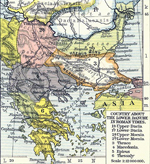
MACEDONIA IN ROMAN TIMES
Click to enlarge
How Do We Know
What We Know About Alexander?
The main sources for Alexander's history are the following
historians:
Diodorus
Curtius (Quintus Curtius Rufus)
Plutarch
Arrian
Justin (Justinus)
Alexander the
Great Trivia
A Greek newspaper reports that Macedonia renamed its Skopje
airport "Alexander the Great."
 Article here. Article here.
Here you
will find
 Alexander the Great's timeline. Alexander the Great's timeline.
And here is more on
 Alexander's horse Bucephalus.
Alexander's horse Bucephalus.

 Bucephalus
Bucephalus
More History
|